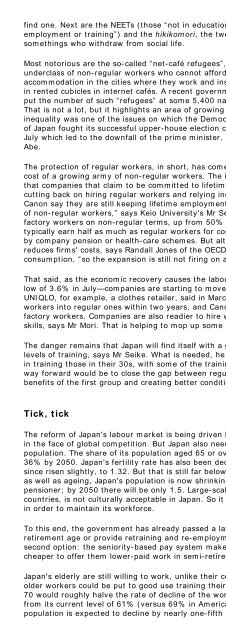The Economist December 1st 2007 - Online Public Access Catalog
The Economist December 1st 2007 - Online Public Access Catalog
The Economist December 1st 2007 - Online Public Access Catalog
- No tags were found...
You also want an ePaper? Increase the reach of your titles
YUMPU automatically turns print PDFs into web optimized ePapers that Google loves.
find one. Next are the NEETs (those “not in education,employment or training”) and the hikikomori, the twentysomethingswho withdraw from social life.Most notorious are the so-called “net-café refugees”, anunderclass of non-regular workers who cannot affordaccommodation in the cities where they work and instead sleepin rented cubicles in internet cafés. A recent government reportput the number of such “refugees” at some 5,400 nationwide.That is not a lot, but it highlights an area of growing concern:inequality was one of the issues on which the Democratic Partyof Japan fought its successful upper-house election campaign inJuly which led to the downfall of the prime minister, ShinzoAbe.<strong>The</strong> protection of regular workers, in short, has come at thecost of a growing army of non-regular workers. <strong>The</strong> irony isthat companies that claim to be committed to lifetime employment can meet this commitment only bycutting back on hiring regular workers and relying increasingly on non-regular workers. “Toyota andCanon say they are still keeping lifetime employment, but to do so they are introducing a large numberof non-regular workers,” says Keio University's Mr Seike. Canon, for example, now employs 70% of itsfactory workers on non-regular terms, up from 50% in 2000 and 10% in 1995. Non-regular workerstypically earn half as much as regular workers for comparable work. About half of them are not coveredby company pension or health-care schemes. But although the use of low-paid, non-regular workersreduces firms' costs, says Randall Jones of the OECD, it has the broader effect of constrainingconsumption, “so the expansion is still not firing on all cylinders.”That said, as the economic recovery causes the labour market to tighten—unemployment hit a nine-yearlow of 3.6% in July—companies are starting to move some non-regular workers into regular positions.UNIQLO, for example, a clothes retailer, said in March that it would turn 5,000 of its 6,000 non-regularworkers into regular ones within two years, and Canon said it would do the same for 1,000 of its 13,000factory workers. Companies are also readier to hire workers in their 30s, particularly those with specificskills, says Mr Mori. That is helping to mop up some of the lost-generation freeters.<strong>The</strong> danger remains that Japan will find itself with a generation of middle-aged workers with inadequatelevels of training, says Mr Seike. What is needed, he says, is a scheme to encourage companies to investin training those in their 30s, with some of the training costs provided by the government. But the bestway forward would be to close the gap between regular and non-regular workers by reducing the pay andbenefits of the first group and creating better conditions for the second.Tick, tick<strong>The</strong> reform of Japan's labour market is being driven by the need to become more competitive and flexiblein the face of global competition. But Japan also needs to tackle a longer-term threat: the ageing of itspopulation. <strong>The</strong> share of its population aged 65 or over, currently 21%, will rise to 25% by 2014 and36% by 2050. Japan's fertility rate has also been declining, hitting a low of 1.26 in 2005, though it hassince risen slightly, to 1.32. But that is still far below the replacement rate of 2.1 children per woman. Soas well as ageing, Japan's population is now shrinking. By 2030 Japan will have two workers for everypensioner; by 2050 there will be only 1.5. Large-scale immigration, the solution favoured in other richcountries, is not culturally acceptable in Japan. So it will have to put more women and old people to workin order to maintain its workforce.To this end, the government has already passed a law requiring companies to raise their mandatoryretirement age or provide retraining and re-employment for older workers. Most companies favour thesecond option: the seniority-based pay system makes the oldest workers the most expensive, so it ischeaper to offer them lower-paid work in semi-retirement than to keep them on as full-time employees.Japan's elderly are still willing to work, unlike their counterparts in Europe, notes Mr Seike. In theory,older workers could be put to good use training their younger colleagues. Raising the retirement age to70 would roughly halve the rate of decline of the workforce. Increasing the participation rate of womenfrom its current level of 61% (versus 69% in America) would help even more. Japan's working-agepopulation is expected to decline by nearly one-fifth by 2030, and boosting female participation would be
















